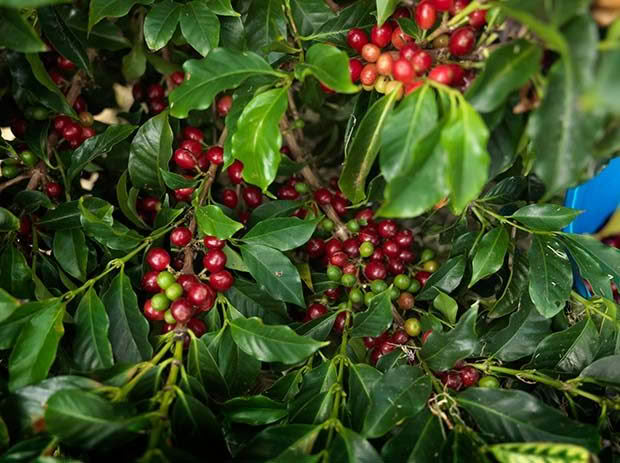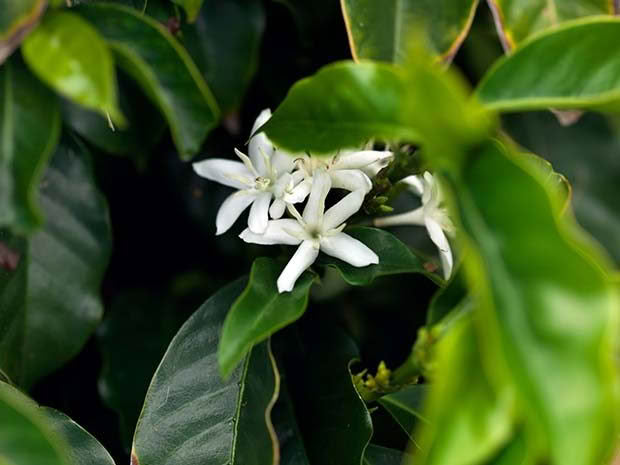Inside New Zealand’s first commercial coffee harvest
On the hills above Doubtless Bay in the Far North live New Zealand’s first commercial coffee growers. Establishing the world’s southernmost coffee farm has had its challenges – luckily its owners are full of beans.
Words: Kate Coughlan / Additional words: Nadene Hall Photos: Jane Ussher
Who: Rob Schluter
What: Ikarus Coffee
Land: 2ha (5 acres)
Where: Pekerau, on the ridge between Rangaunu Harbour and Doubtless Bay, 160km north of Whangarei
Web: www.ikaruscoffee.co.nz
When Rob returned to New Zealand from Europe 22 years ago, they were keen to connect with the land.
Rob grew up on a Northland dairy and beef farm but spent three years in Vienna in the 1990s.
“It is a wonderful place to live, but it’s a totally different way of living,” says Rob. “When you’re talking about a 30 square metre apartment and you’ve grown up on a thousand acres, it’s quite a contrast.”

He was ready to get his hands into the soil and get growing. On their small block at Pekerau, almost as far north as you can get, they experimented with a variety of plants to see what would grow well in their subtropical environment.
Initially, they thought their future lay with vireya rhododendrons. But they gave themselves options and planted a wide variety of food crops and ornamentals, including olive trees and some coffee bushes.

The 2ha farm in Pekerau, Northland.
Of all the many sub-tropicals they planted, it was the five Coffea arabica – the variety most commonly used in freshly brewed coffee – which fired their imagination.
“There’s two different species,” says Rob. “Coffea robusta is what they make into mostly instant coffee, it’s got a higher caffeine content, a totally different character.”
It also doesn’t grow here, but cold-tolerant Coffea arabica liked what it found on the Schluter’s block.
READ MORE: Growing Coffee in New Zealand’s temperate climate
“We became fascinated by the magic and mystique of coffee,” says Rob. “In 2012 we decided to get hands-on with picking and processing the whole crop to find out what we could do with it. We eventually had about 3kg of roasted coffee and, with really positive feedback, we got serious and committed to establishing a viable coffee farm.”

Since then, the pioneering couple has grown and planted out around 700 trees. Their 2017-2018 harvest is 700kg of ‘cherries’, the term for the ripe coffee fruit which is red when picked. It then takes a few months to go through the time-consuming process of picking, pulping, fermentation and conditioning of the beans, hulling, roasting and finally marketing it under their label, Ikarus Coffee.
“So it’s not like blueberries, where every kilo that’s picked fetches the per kilogram return,” says Rob. “With so much weight loss during processing, coffee is a labour of love which is why the process, including the roasting, gives us such a real appreciation of what coffee is all about.”
The world supply of coffee is around 8.8 million metric tons, from 70 countries that produce it.
The top 10 producers* are:
Brazil (31%)
Vietnam (16%)
Colombia (8%)
Indonesia (7%)
Ethiopia (4.5%)
India (3.4%)
Honduras (3.4%)
Guatemala (2.3%)
Peru (2.3%)
Uganda (2.3%)
* as at 2014
Rob says their project is still very much in an experimental phase. Most of the world’s 25 million coffee growers live in the top 10 producing countries of the world, and most are on small properties about the same size as their block. However, none are as far south as this. There are 70 countries that grow coffee successfully, all in a band that borders the equator and south to around the southern tip of Brazil.
While you can measure how far outside the common growing areas the hills of Pekerau are, it’s a lot more complicated than drawing a straight line, says Rob.
“We’re 200m high on a hill as well. The further you are away from the equator, the more you’re mimicking a higher altitude of an equatorial region so we’re the equivalent of a very high altitude in the tropics.”
In an article on coffee-growing in New Caledonia, Rob read that the island’s location for growing coffee – 25m above sea level – was the equivalent of 950m above sea level at the equator.

Even if the ‘cherries’ ripen you’re still not guaranteed a bean at the end of it.
“We’re 2000km further south (than New Caledonia), way outside the coffee belt. We’re on the extreme fringe. This increases the intensity of ultraviolet light – the further you are away, the clearer the atmosphere and the more the intensity of light, which is good.”
Climate is the main determinant for coffee growing. Their maritime subtropical temperatures make it possible for the plants to fruit, says Rob.
“(But) growing 1200km outside the coffee-growing belt means that fruiting does not equate to bean-set. We have four different varietals, and we are observing which ones are the best at bean-set.”
Some of these varietals originated from a selection made about 30 years ago by the then-Government-run Department of Scientific and Industrial Research (DSIR). They have found a semi-dwarf variety from Brazil seems to perform the best. They are also experimenting with a new varietal, a dwarf-mutation which grows to a compact size.
There will be selective replanting of varietals that show good crop weight and have beans with flavour. However, a healthy tree and a big harvest of cherries is no guarantee of beans which makes choosing the right trees to grow on that much more complex.
“It comes down to environmental conditions at the time of flower development,” says Rob. “From what I’ve researched, it is definitely to do with the pollination at the point of flowering. It’s good that they don’t always flower at one point in time. This year, with a lot of humidity and moisture, they were flowering way earlier than what they have done in previous years and they were flowering sort-of sporadically off and on.
“If they don’t get pollinated or if there’s too much wind then they might show a fruit set, but not a bean set. Different plants, different varietals, they’re performing differently.”

It’s a challenge to get flower set so far south.
Rob says the project has given them a greater appreciation for the world’s 25 million coffee growers. He has a goal of running a viable, sustainable coffee farm which he estimates to be around 1200 trees with a consistent, annual bean-set of 60-90 per cent. That would produce half to one tonne of roasted beans, or approximately 50,000-100,000 cups of coffee.
“I won’t know if it’s going to be worthwhile until I can establish a performing varietal. And even then it will come down to customer appreciation and what they’re willing to pay for it. But what keeps me motivated is the idea of producing coffee all the way from a seed through to the roasted product, giving the option of a unique, locally-grown coffee.”

DOES NZ HAVE A FUTURE IN COFFEE?
They may be the only professional coffee growers in NZ, but it’s possible climate change will mean there are more in future.
A 2016 report by the Climate Institute (commissioned by Fairtrade Australia & New Zealand) looked to better understand the extent to which climate change is impacting coffee production globally.
It found strong evidence that rising temperatures and altered rainfall patterns are already affecting coffee yields, quality, pests, and diseases, badly affecting economic security in some coffee regions.
It reports without strong action to reduce emissions, climate change is projected to cut the global area suitable for coffee production by up to 50 per ent by 2050. By 2080, wild coffee plants, an important genetic resource for farmers, could become extinct.
It would also mean in the next few decades, coffee production will undergo dramatic shifts, broadly, away from the equator and further up mountains.
Source: A Brewing Storm: The climate change risks to coffee
READ MORE
Growing coffee plants in New Zealand’s temperate climate and how to roast fresh beans

